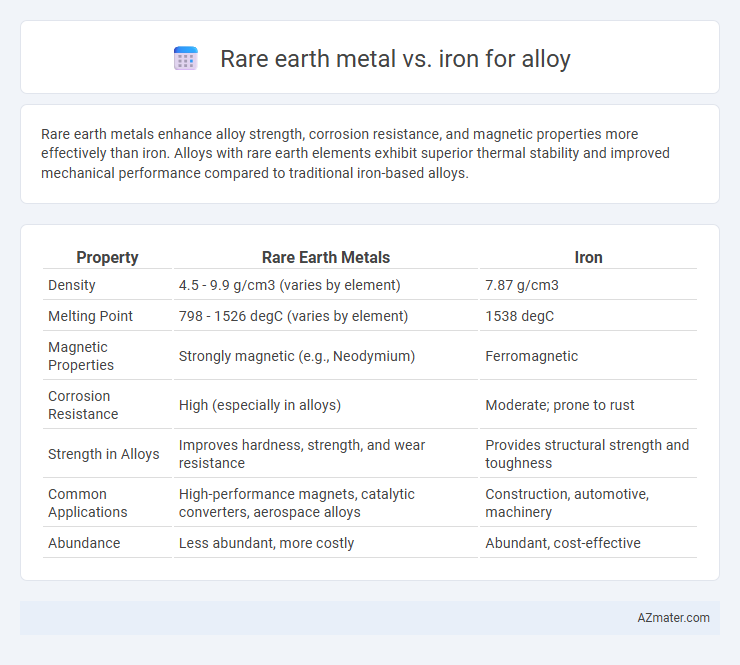Rare earth metals enhance alloy strength, corrosion resistance, and magnetic properties more effectively than iron. Alloys with rare earth elements exhibit superior thermal stability and improved mechanical performance compared to traditional iron-based alloys.
Table of Comparison
| Property | Rare Earth Metals | Iron |
|---|---|---|
| Density | 4.5 - 9.9 g/cm3 (varies by element) | 7.87 g/cm3 |
| Melting Point | 798 - 1526 degC (varies by element) | 1538 degC |
| Magnetic Properties | Strongly magnetic (e.g., Neodymium) | Ferromagnetic |
| Corrosion Resistance | High (especially in alloys) | Moderate; prone to rust |
| Strength in Alloys | Improves hardness, strength, and wear resistance | Provides structural strength and toughness |
| Common Applications | High-performance magnets, catalytic converters, aerospace alloys | Construction, automotive, machinery |
| Abundance | Less abundant, more costly | Abundant, cost-effective |
Introduction to Rare Earth Metals and Iron Alloys
Rare earth metals, including elements like neodymium and dysprosium, significantly enhance the magnetic, thermal, and corrosion resistance properties of iron alloys, making them vital for high-performance applications. Iron alloys, commonly composed of iron mixed with carbon and other elements, benefit from rare earth additions by exhibiting improved strength, ductility, and resistance to oxidation. These enhancements are critical in sectors such as automotive, aerospace, and electronics, where material longevity and efficiency are paramount.
Chemical and Physical Properties Comparison
Rare earth metals, characterized by high magnetic strength, low density, and excellent corrosion resistance, enhance alloy performance by improving hardness, thermal stability, and electrical conductivity compared to traditional iron-based alloys. Iron alloys offer superior tensile strength, ductility, and cost efficiency, with a body-centered cubic structure that provides robustness but typically lower resistance to oxidation and magnetization than rare earth elements. The integration of rare earth elements such as neodymium or dysprosium in iron alloys results in advanced magnetic properties and corrosion resistance, crucial for high-performance applications in aerospace and electronics.
Occurrence and Availability: Rare Earths vs. Iron
Iron is abundantly available in the Earth's crust, making it one of the most widely used metals in alloy production due to its consistent supply and low extraction cost. Rare earth metals, while essential for their unique magnetic and catalytic properties, occur in much lower concentrations and are geographically concentrated, leading to supply chain vulnerabilities. The limited availability and complex extraction processes of rare earth elements contrast sharply with iron's widespread occurrence, impacting their respective roles in alloy manufacturing.
Alloying Behavior and Processability
Rare earth metals significantly enhance alloying behavior by improving grain refinement, oxidation resistance, and magnetic properties, which are critical for high-performance materials compared to iron. Iron alloys tend to have more straightforward processability but often lack the specialized properties that rare earth elements impart, such as increased hardness and corrosion resistance. The incorporation of rare earth metals typically requires precise control during melting and solidification to optimize alloy performance and avoid brittleness.
Mechanical Strength and Durability
Rare earth metals such as neodymium and dysprosium enhance alloy performance by significantly improving mechanical strength and wear resistance compared to traditional iron-based alloys. These metals contribute to refined grain structures and increased hardness, resulting in alloys that exhibit superior fatigue resistance and longer service life under high-stress conditions. Iron alloys, while cost-effective and versatile, generally lack the durability and strength enhancements provided by rare earth element additions in advanced engineering applications.
Magnetic Properties and Applications
Rare earth metals such as neodymium and samarium significantly enhance magnetic properties when alloyed with iron, producing strong permanent magnets like neodymium-iron-boron (NdFeB) and samarium-cobalt (SmCo), which exhibit high coercivity and remanence. These alloys surpass pure iron and traditional steels in magnetic performance, making them essential in electric motors, wind turbine generators, and hard disk drives. The unique electron configurations of rare earth elements contribute to exceptional magnetic anisotropy and thermal stability in these high-performance alloys.
Corrosion Resistance: Which Performs Better?
Rare earth metals significantly enhance the corrosion resistance of iron-based alloys by forming stable oxide layers that protect against rust and environmental degradation. Incorporating cerium or lanthanum into iron alloys improves resistance to oxidation and pitting in harsh conditions. Iron alone is more susceptible to corrosion, especially in acidic or saline environments, making rare earth-infused alloys superior for long-term durability.
Industrial and Technological Applications
Rare earth metals enhance alloys with superior magnetic, catalytic, and corrosion-resistant properties, crucial for advanced electronics, renewable energy technologies, and high-performance magnets used in electric vehicles and wind turbines. Iron, fundamental in steel production, offers strength and durability for construction, automotive, and heavy machinery industries but lacks the specialized magnetic and lightweight characteristics found in rare earth alloys. The integration of rare earth metals into iron-based alloys significantly improves mechanical performance and technological efficiency in industrial applications.
Environmental Impact and Sustainability
Rare earth metals in alloys offer enhanced performance but pose significant environmental challenges due to energy-intensive mining and toxic waste generation, raising sustainability concerns. Iron, abundantly available and recyclable, presents a lower environmental footprint and easier integration into circular economies, making it a more sustainable choice for alloy production. However, optimizing iron alloy properties without rare earth additions remains critical for balancing performance and environmental impact.
Cost Considerations and Economic Feasibility
Rare earth metals in alloys typically incur higher costs due to limited global reserves and complex extraction processes compared to abundant and inexpensive iron. The economic feasibility of using rare earth metal alloys depends on their enhanced properties justifying the increased material and processing expenses. Iron-based alloys remain more cost-effective for large-scale industrial applications where high strength-to-cost ratio is critical.

Infographic: Rare earth metal vs Iron for Alloy
 azmater.com
azmater.com